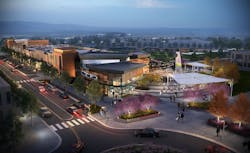The city of El Paso is embarking on a major investment in transit, in the form of bus rapid transit (BRT), as a first step of changing the development patterns in the community to be more pedestrian friendly and less dependent upon the automobile. Long recognized as a “Smart Code” community, El Paso has promoted organized growth according to adopted zoning, land-use planning, and design standards from the Congress for New Urbanism, which drives for pedestrian-friendly, walkable communities reminiscent of historic communities around the country.
Where transit-oriented development (TOD) has traditionally been associated with light rail and commuter rail, El Paso intends to change this stereotype by using BRT as the catalyst for new urban economic development.
In August, the city of El Paso, and Sun Transit broke ground on a new $15 million intermodal transfer center on the site of the demolished Northgate shopping center. This new transit center will anchor a new TOD being developed by a local El Paso developer, Hunt, and will drive economic development for the redevelopment of the 30-acre demolished mall site.
Setting BRT Up for Success
In the past, BRT has not been associated with TOD. Even though buses are often the cheapest, most effective means of getting more people from Point A to B, bus transit has traditionally not been seen in the same way as a fixed-rail system. The permanence of the fixed-rail alignment drives real estate values, which drive economic development of mixed-use, higher density development.
Meanwhile, buses (and the associated stops) are seen as more transient. A bus stop can be moved. Plus, buses often come with a reputation (deserved or otherwise) for being crowded, uncomfortable, run-down or inconvenient. These factors have — until recently — added up to a lack of investment in bus transit as an attractive transportation option. Even when they do invest, cities often neglect to make transit-oriented development a priority for major bus station centers like they would a light rail station. Equally important, private developers rarely invest in bus related TOD improvements.
That’s unfortunate considering the reality that bus service can provide an excellent solution in all but the most densely populated communities, and all but the largest metro growth areas.
BRT can be a great option, especially for mid-sized cities, such as El Paso or Grand Rapids, Michigan. These cities are growing, middle-tier cities with emerging congestion and sprawl problems, many of which need better alternatives than the single-occupancy car and the conventional bus.
For these types of communities, BRTs come with significant incentives for the cities that invest in them and the commuters that ride them. Cities that have already developed BRT have seen local air pollutant emissions reduction, travel time-savings, traffic safety improvements, increased physical activity, the attraction of private investment in the area and the creation of jobs.
BRT is also a good alternative in more urban, built-up corridors where there is no right of way for rail, and where acquiring properties for fixed guideways is prohibitive. Thus BRT becomes a way to utilize existing street capacity to carry more people faster and easier.
What makes the Northgate Transfer Center project so special?
While BRT has in the past not had the ‘cache’ of rail, The Northgate end-of-line transfer center will be a significant departure from normal BRT system design.
At this location, the transfer center will create a major new focal point for the community, complete with 25,000 square feet of retail, a parking garage that will be shared by transit patrons and the surrounding development, and a new "station" that will be a significant community feature. Perhaps most significant is the creation of a new town square that will be used by the community as a gathering place for events, farmer’s markets, and local festivals and activities. This public square will center directly on the primary ‘main and main’ intersection of the new TOD, and when completed, will be the gateway to the community from the transit center. This TOD is the first of its kind to receive major federal funding and will hopefully serve as a national model for transit-oriented development stimulated by BRT in cities of similar size to El Paso.
Exigo, a local architectural practice, teamed with RNL, an international architecture, planning and design firm that specializes in transit facilities. Together, the team developed an innovative and dynamic new addition to the community that will become the focal point for economic development for years to come. This project is a significant departure from the typical bus shelter approach typically taken for BRT stations, and instead makes a significant investment in transit infrastructure that is intended to change the perception of bus transport, and to drive TOD through public investment in these new community amenities.
This project will truly demonstrate how BRT investment in emerging urban centers can drive new walkable, pedestrian-oriented redevelopment in typical suburban sprawl settings, and how BRT can create urban investment in abandoned locations such as the Northgate Mall. While transit is the catalyst to make it happen, creating wonderful new community amenities is the motivator for private sector development that will follow.
Richard L. von Luhrte FAIA is a senior principal at RNL.

Richard von Luhrte | Senior Principal
Richard von Luhrte has more than 45 years’ experience in placemaking and commercial development in community building. He was previously the chief architect for the Regional Transportation District in Denver and has been instrumental in building RNL’s national reputation in major transit projects around the nation.




